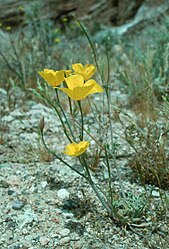
Eschscholzia californica, the California poppy, golden poppy, California sunlight or cup of gold, is a species of flowering plant in the family Papaveraceae, native to the United States and Mexico. It is cultivated as an ornamental plant flowering in summer, with showy cup-shaped flowers in brilliant shades of red, orange and yellow. It is also used as food or a garnish. It became the official state flower of California in 1903.

Dipterostemon is a monotypic genus of flowering plants in the family Asparagaceae. Its only species is Dipterostemon capitatus, synonym Dichelostemma capitatum, known by the common names blue dicks, purplehead and brodiaea, native to the Western United States and northwest Mexico.
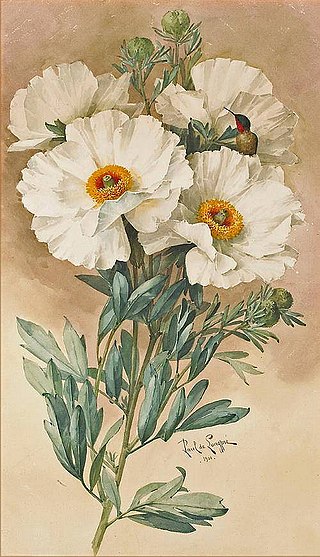
Romneya coulteri, the Coulter's Matilija poppy or California tree poppy, is a perennial species of flowering plant in the poppy family Papaveraceae. Native to southern California, USA, and Baja California, Mexico, it grows in dry canyons in chaparral and coastal sage scrub plant communities, sometimes in areas recently burned. It is a popular ornamental plant, kept for its large, showy flowers.

Hunnemannia is a monotypic genus of flowering plants in the poppy family Papaveraceae, containing the single species Hunnemannia fumariifolia native to the highlands of Mexico. It is typically found at elevations of 1,500–2,000 m (4,921–6,562 ft) in the Chihuahuan Desert and south into central Mexico, where it favors rocky habitats, occurring along roadsides as well.

Argemone munita is a species of prickly poppy known by the common names flatbud prickly poppy and chicalote. "Munita" means "armed", in reference to the many long prickles. This flower is native to California, where it is widespread throughout the western part of the state and its eastern deserts, on slopes to 10,000 feet, and along roadsides. Its range also extends into Baja California, Arizona, and Nevada.

Delphinium hansenii is a species of larkspur known by the common names Eldorado larkspur and Hansen's delphinium. It is endemic to California, where it grows in mountains, valleys, and desert from the southern Cascade Range to the Mojave Desert.

Eschscholzia caespitosa is a species of poppy known by the common names foothill poppy, tufted poppy and collarless California poppy.

Eschscholzia glyptosperma is a species of poppy known by the common names desert gold poppy, desert golden poppy, and Mojave poppy.
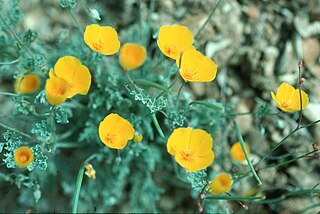
Eschscholzia hypecoides is a species of poppy known by the common name San Benito poppy.

Eschscholzia lobbii is a species of poppy known by the common name frying pans. It is endemic to California, where it grows in the Central Valley and adjacent Sierra Nevada foothills. The frying pans is a small annual herb growing from a patch of segmented leaves with pointed leaflets. It produces erect stalks up to 15 centimeters in height each bearing a single poppy flower. The petals are about a centimeter long and bright yellow to somewhat orange. The fruit is a capsule 3 to 7 centimeters long containing tiny brown seeds.
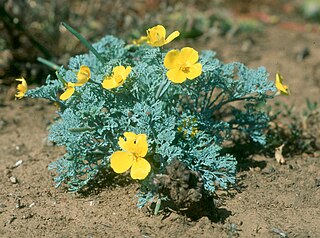
Eschscholzia ramosa is a species of poppy known by the common name Channel Islands poppy, or simply island poppy.

Arctomecon merriamii is a species of poppy known by several common names, including desert bearpoppy, white bearpoppy, and great bearclaw poppy. It is native to the Mojave Desert of California and Nevada.
Astragalus cimae is a species of milkvetch known by the common name Cima milkvetch. It is native to the Mojave Desert and its sky island woodlands of eastern California western Nevada, especially on calcareous soils, including the Cima Dome area in the Mojave National Preserve.
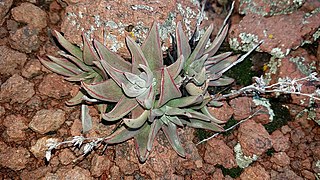
Dudleya abramsii is a species complex of succulent plants native to California and parts of Baja California. There are numerous subspecies, some critically endangered, with varying habits and lifestyles, but most often characterized by a smaller size, yellow flowers, and an affinity for rocky habitats. The subspecies may be polyphyletic.

Dudleya attenuata is a species of perennial succulent plant known by the common name taper-tip liveforever, native to Baja California and a small portion of California. A rosette-forming leaf succulent, it has narrow pencil shaped leaves that can often be found covered in a white epicuticular wax. The thin, sprawling stems branch to form the clusters of rosettes, with plants creating a "clump" up to 40 cm wide. The small flowers are white or yellow, with 5 spreading petals. It is a diverse, variable species that extends from the southernmost coast of San Diego County to an area slightly north of the Vizcaino Desert, hybridizing with many other species of Dudleya in its range. Some plants with white or pinkish flowers were referred to as Orcutt's liveforever, referring to a former subspecies split on the basis of the flower color.

Dudleya ingens is a species of perennial succulent plant in the family Crassulaceae commonly known as the rock liveforever or Baja liveforever. A relatively large member of the genus Dudleya, this species has long green succulent leaves, and in April to June is characterized by pale yellow to white pink-tinged flowers topping tall, reddish inflorescences. It has a stem clothed densely with old, leathery leaves, and the inflorescence may be nodding, with the floral branches bearing the flowers tending to unfurl like the fronds of a fern. It is similar in appearance to Dudleya brittonii, but differs in range and chromosome number. This species is endemic to the state of Baja California in Mexico, being found from Santo Tomás to the southern coast of the state.

Canbya candida is a tiny, white flowered annual plant in the genus Canbya of the poppy family. It is found in the western Mojave Desert of Southern California. It grows 1–3 cm tall. Its leaves are 5–9 mm long. The flowers are borne in leaf axils, and have 5–7 white petals that are each 3–4 mm long, and 6-9 stamens.
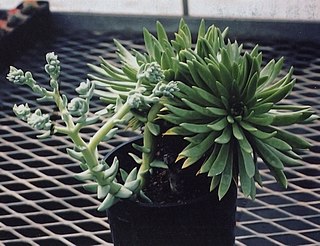
Dudleya guadalupensis is a very rare species of succulent perennial plant in the family Crassulaceae commonly known as the Guadalupe liveforever. It is a rosette-forming leaf succulent, with foliage that is variously colored light green, green, and a waxy white. It is characterized by dense leaves that fold over the center in dormancy, a curving, sinuous flower stalk, and white, cup-shaped flowers. It is endemic to the rocks and islets off of Guadalupe Island, an isolated volcanic island in the Pacific Ocean located 241 kilometers off of the coast of Baja California.

Dudleya saxosa subsp. collomiae, known by the common name Gila County liveforever, is a subspecies of perennial succulent plant within the genus Dudleya native to central Arizona. It is characterized by showy bright-yellow flowers on an upright inflorescence colored pink, red or orange. The leaves are green or covered in a white, powdery wax. This species is found growing in rocky slopes, canyons, and crevices, and often on Sonoran Desert sky islands.

Dudleya saxosasubsp. aloides is a species of perennial succulent plant in the family Crassulaceae known by the common names desert dudleya or desert savior. It is a rosette-forming species widely distributed throughout the Peninsular Ranges and desert mountains of California in the United States. It is characterized by bright-yellow or greenish-yellow flowers, and can be found in shaded crevices and slopes. Plants in western half of the range may grade into Dudleya lanceolata.



